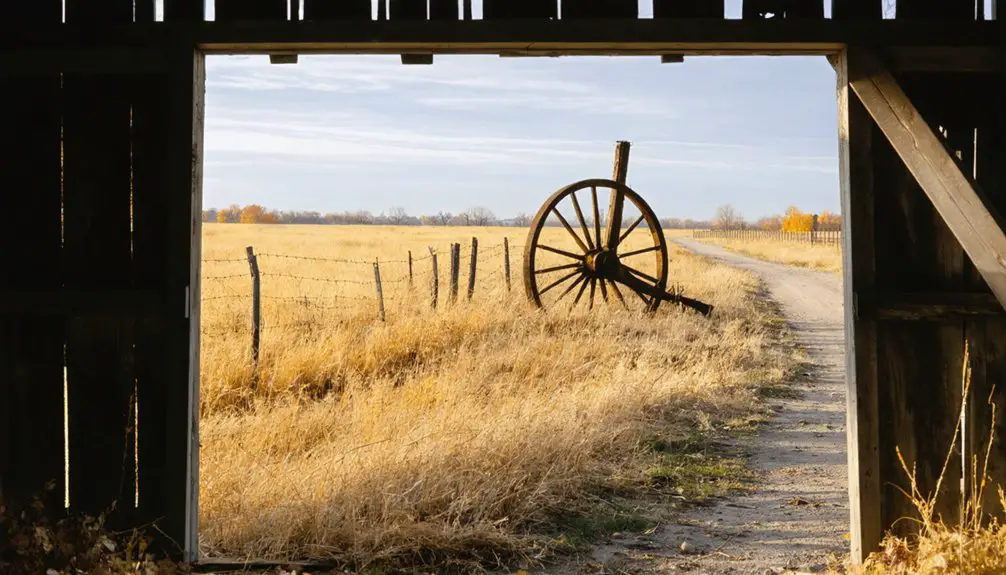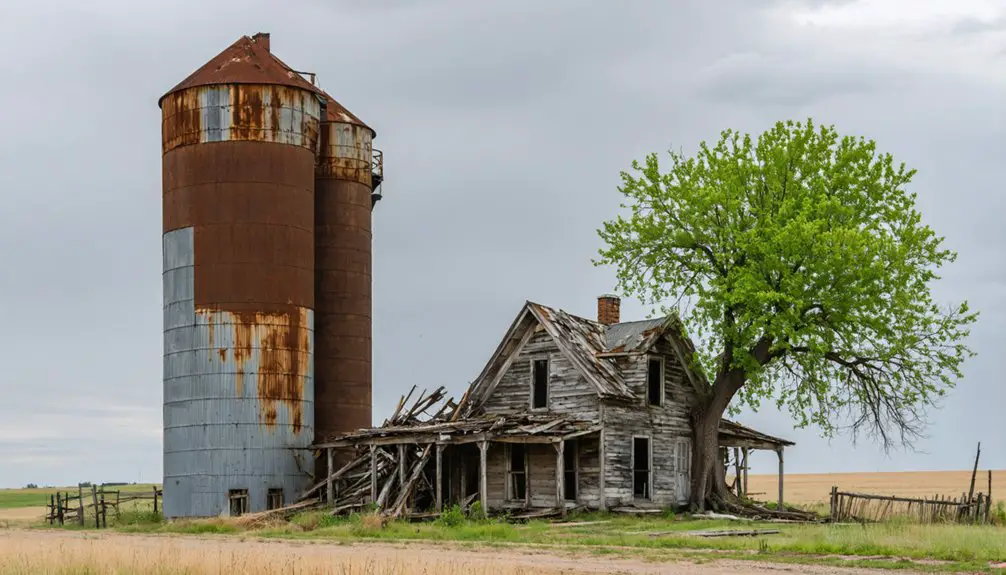You’ll find New Prairie’s ghost town remnants in Minnesota’s Pope County, where it once thrived as a bustling agricultural settlement in the late 19th century. The Northern Pacific Railway established a station there in 1871, attracting settlers, merchants, and farmers who built a close-knit community. After the railroad’s discontinuation and economic shifts, residents gradually departed, leaving behind an abandoned schoolhouse, church site, and cemetery that tell tales of prairie life’s rise and fall.
Key Takeaways
- New Prairie was a thriving 19th-century Minnesota settlement that grew around the Northern Pacific Railway station established in 1871.
- The community flourished as an agricultural hub until railroad service discontinuation led to its eventual abandonment.
- Post-Civil War settlement included approximately 200 veteran families seeking new opportunities in farming and commerce.
- Population peaked in the early 1900s before declining as residents sought better opportunities in nearby towns like Cyrus and Starbuck.
- Historical remnants include abandoned buildings, an old schoolhouse, church site, railway tracks, and a nearby cemetery.
The Rise of a Prairie Settlement
As Native American tribes like the Sioux and Ojibwe roamed the prairies of what would become Minnesota, early European explorers Henry Schoolcraft and Joseph Nicollet began mapping the region that included New Prairie.
The settlement patterns that followed were shaped by the 1837 treaties, which opened lands for European settlement while displacing indigenous peoples. Early archaeological evidence reveals burial mounds dating from around 700 BC scattered throughout the region. The Civil War’s end brought a wave of approximately 200 veteran families seeking new beginnings in the area.
The 1837 treaties reshaped Minnesota’s landscape, creating new opportunities for European settlers while forcing Native Americans from their ancestral lands.
You’ll find that fur trading dominated the early economy, with trading posts serving as essential hubs for commerce between settlers and Native Americans.
Cultural influences merged as settlers adapted to prairie life, incorporating indigenous practices like maple sugaring while establishing their own agricultural communities.
Military-built roads and land surveys conducted between 1848-1857 using a grid system helped transform the wild prairie into organized parcels ready for ambitious settlers seeking new opportunities.
Railroad’s Role in Town Development
You’ll find that New Prairie’s transformation began with the Northern Pacific Railway‘s decision to establish a station there in 1871, marking the town as a crucial transportation hub for the region.
Much like the current Minnesota State system, the station’s strategic placement attracted settlers, merchants, and farmers who recognized the economic advantages of having direct rail access to larger markets in Minnesota and the Dakota Territory.
As the railroad infrastructure expanded with new branch lines and improved facilities, New Prairie quickly developed into a bustling center of commerce where agricultural products could be efficiently shipped and received. The town’s growth paralleled the railway’s mission to support farming and ranching across its land grants.
Railroad Station Development
While many frontier towns emerged organically, the railroad’s arrival in the 1870s systematically transformed the development of new settlements across Minnesota and the western territories. These train depots became vital economic centers where immigrants and farmers conducted commerce and trade.
You’ll find that railroad expansion typically began with small, simple station buildings that served as vital anchors for growing communities. These initial structures reflected local architectural styles and available materials, often starting modestly before expanding to meet increasing demands. Following the example of Eden Prairie’s station built in 1871 by Washburn, development patterns showed how railroad infrastructure shaped town growth.
- Stations began as basic depots for freight and passenger services
- Railroad companies invested in essential infrastructure, including roads and utilities
- Buildings adapted over time to accommodate growing population needs
- Station architecture evolved from simple wooden structures to more elaborate designs
- Depots served as community hubs, combining transportation services with social gathering spaces
Transportation Hub Impacts
The arrival of the Northern Pacific Railway in 1870 transformed Minnesota’s landscape into a network of thriving transportation hubs, fundamentally reshaping the region’s development patterns.
You’ll find that these hubs sparked unprecedented economic connectivity, creating crucial links between isolated communities and major markets.
As the transportation evolution unfolded, you’d have witnessed the emergence of intermodal connections where rail lines met rivers and lakes, maximizing trade efficiency.
The Minneapolis and St. Louis Railway established critical routes in the 1880s that helped develop Minnesota’s agricultural communities.
Railroad stations became catalysts for local growth, spurring the development of essential services like lodging and maintenance facilities.
The railways didn’t just move goods and people; they created jobs, stimulated industrial growth, and facilitated cultural exchange.
Engineers tackled harsh climates and challenging terrain, developing innovative solutions that enabled year-round operations and sustained community development throughout the region. The expansion reached Moorhead, Minnesota, establishing it as a vital railway junction in the state’s growing transportation network.
Daily Life on the Minnesota Prairie
Living on Minnesota’s prairie required tremendous resilience as settlers faced unpredictable weather extremes, from bitter cold winters to scorching summers and devastating droughts. Local Grange chapters founded by Oliver Hudson Kelley helped Minnesota farmers survive these challenges through organized support.
You’d spend your days managing a constant stream of chores, from tending crops to maintaining your simple farmhouse. Without modern conveniences, you’d rely on coal ranges for cooking and icehouses for food preservation. Czech immigrants established tight-knit farming networks that supported each other through difficult times.
Community bonds became your lifeline, with social gatherings and cultural festivals providing essential relief from daily hardships.
- You’d join the Grange to share farming knowledge and participate in community activities
- Your whole family would contribute to farm work, including children
- You’d store ice from nearby rivers to keep food fresh throughout warm months
- Your home would use piped warm air furnaces for heating during brutal winters
- You’d adapt to economic challenges by developing innovative farming techniques and tools
Agricultural Legacy and Economic Impact
Minnesota’s agricultural revolution began in 1858 when farmers first raised wheat commercially in the southeastern region.
As you’d have seen back then, rising land prices and soil depletion pushed farmers to explore new opportunities in western and northwestern territories, particularly the Red River Valley.
Agricultural innovations transformed the landscape during the 1870s-1890s.
You’d have witnessed the rise of massive bonanza farms equipped with steel-blade plows and mechanical harvesters.
But these operations couldn’t last forever – soil exhaustion and market pressures forced change.
Economic diversification became essential for survival.
Farmers switched to dairy, corn, and other specialized crops, while forming cooperatives to combat market monopolies.
Minnesota farmers adapted by diversifying into dairy and corn while building cooperative networks to fight powerful market forces.
This shift from wheat dependence to varied agriculture created a lasting legacy that’s shaped Minnesota’s farming identity.
Post Office: A Community Hub

Since its establishment in 1872, New Prairie’s post office emerged as an essential community hub, serving local residents through two distinct operational phases.
You’ll find fascinating historical narratives woven into its timeline, from its initial closure in 1883 due to railway developments, to its revival in 1920. The post office fostered community connection until its final closure in 1946, marking the end of an era in New Prairie’s history.
- Operated as the primary information and mail service center for 37 years across two periods
- Relocated to the railway station in 1883, reflecting the region’s evolving infrastructure
- Served as a central gathering point for local news and community activities
- Facilitated crucial communication between New Prairie and the outside world
- Maintained operations through significant local developments and railway expansion
The People Who Called New Prairie Home
While historical records don’t reveal exact population figures for New Prairie, the town’s residents formed a close-knit agricultural community during the late 19th century.
You’ll find that these settlers, many of whom were likely European immigrants, made their living primarily through farming and railroad-related activities. The Northern Pacific Railroad station served as the town’s economic backbone, connecting residents to broader markets and opportunities.
Community memories suggest that daily life revolved around agricultural pursuits, with families working together to cultivate the fertile Minnesota soil.
Though specific details about their cultural heritage remain sparse, you can imagine the shared experiences of these pioneering families – from seasonal harvests to outdoor recreational activities like hunting.
Their lives were shaped by the rhythms of rural life and the challenges of establishing a new settlement on the prairie.
Decline and Abandonment

As you examine New Prairie’s decline, you’ll notice the town’s population began dwindling in the late 19th century when residents sought better opportunities in growing urban areas.
The discontinuation of railroad service through New Prairie dealt a significant blow to the community’s liveliness, as the Northern Pacific Railroad station had been an essential lifeline for both commerce and connectivity.
You can trace how these combined factors of population exodus and lost railway access created a downward spiral that ultimately led to New Prairie’s abandonment.
Population Exodus Patterns
Throughout the late 19th century, New Prairie experienced a steady population decline that followed distinct patterns of exodus.
You’ll find that migration patterns initially showed residents moving to nearby towns like Cyrus and Starbuck, where better economic opportunities existed.
Population trends revealed a clear shift from permanent residents to seasonal agricultural workers, as the town’s sustainability weakened.
- Farmers were the first to leave, selling their lands when agricultural challenges became overwhelming.
- Young families departed next, seeking better educational and healthcare facilities.
- Business owners gradually relocated as customer bases shrank.
- Single adults moved away in search of employment and social opportunities.
- Elderly residents were often the last to leave, holding onto their properties until necessary services disappeared.
Railroad Service Discontinuation
The discontinuation of railroad service dealt a final blow to New Prairie’s struggling community.
As railroad economics shifted during the broader transportation evolution, the Northern Pacific line that once served as the town’s lifeline fell victim to mounting pressures. You’d have seen the impact of increased competition from highways and air transport, while environmental regulations and high maintenance costs made operating the line less viable.
The closure didn’t just affect passenger service – it crippled the movement of goods that New Prairie’s businesses relied upon.
The station’s shutdown marked a turning point, accelerating the town’s decline. What was once a bustling hub along the Northern Pacific Railroad became another casualty of changing times, ultimately contributing to New Prairie’s transformation into a ghost town.
What Remains Today
Modern-day New Prairie exists primarily as farmland between Minnesota cities, with limited physical evidence of its former status as a community. The abandoned infrastructure that once defined this rural heritage has largely disappeared into the landscape, leaving few visible reminders of the town’s existence.
Time has erased New Prairie’s traces, leaving only farmland where a Minnesota community once stood.
You’ll find the area characterized by Minnesota’s typical seasonal changes, from harsh winters to warm summers, supporting local agricultural activities.
- Original railroad station location shows no confirmed structural remains
- Former post office sites have no documented surviving buildings
- Agricultural fields have reclaimed most of the original townsite
- Local wildlife inhabits the rural setting, though specific species aren’t documented
- Land use focuses primarily on farming, reflecting the area’s continued agricultural tradition
Historical Significance in Pope County

Located between Cyrus and Starbuck in Pope County, Minnesota, New Prairie emerged as a noteworthy rural settlement during the 1870s when pioneers like Ole L. Steen established their homesteads.
You’ll find its cultural heritage deeply rooted in the agricultural development that shaped Pope County’s identity. The Northern Pacific Railroad station and post office made New Prairie an essential hub for regional commerce and communication.
As part of Pope County’s rich tapestry, New Prairie’s community dynamics reflected the pioneering spirit that defined western Minnesota’s settlement.
The township’s farmers transformed vast prairie lands into productive agricultural operations, contributing considerably to the county’s economic growth.
Through various challenges, including initial settlement hardships, New Prairie’s residents helped establish the foundation for Pope County’s agricultural prominence.
Preserving New Prairie’s Story
While preserving ghost towns presents unique challenges, New Prairie’s historical legacy lives on through deliberate documentation and community engagement efforts.
You’ll find preservation challenges ranging from physical decay of structures to limited resources, but community involvement has proven essential in maintaining this historic site’s story.
- Digital preservation initiatives help safeguard historical records and photographs
- Local historical societies partner to maintain artifacts and documents
- Community events near the site raise awareness and foster interest
- Oral histories from residents provide invaluable firsthand accounts
- Interactive online platforms make the town’s history globally accessible
The preservation effort mirrors successful approaches used in other Minnesota ghost towns like Maine Prairie Corners and Valley Grove.
Through collaborative work between local government, historical societies, and community members, you’re helping guarantee New Prairie’s significance endures for future generations.
Frequently Asked Questions
Are There Any Documented Supernatural Occurrences in New Prairie’s Abandoned Buildings?
You won’t find documented ghost sightings or haunted locations in New Prairie’s abandoned buildings. While ghost towns often attract supernatural tales, there’s no official record of paranormal activity here.
What Wild Animals Now Inhabit the Former Town Site?
Like pioneers reclaiming the frontier, you’ll find white-tailed deer, rabbits, and coyotes making their homes here. Wildlife sightings include prairie chickens, meadowlarks, and various butterflies in these natural animal habitats.
Did Any Famous People Ever Visit or Stay in New Prairie?
You won’t find any records of famous visitors or historical figures making their way to New Prairie. The village’s small size and brief existence didn’t attract notable personalities.
What Was the Ethnic Composition of New Prairie’s Earliest Settlers?
Like many frontier settlements, you’d find the exact settler origins unclear, but based on Minnesota’s patterns, New Prairie’s earliest residents likely included French-Canadian traders and European immigrants seeking their cultural influences.
Were There Any Major Crimes or Notable Accidents in New Prairie?
You won’t find any documented major crimes or notable incidents in the town’s history records. The crime history appears remarkably quiet, likely due to the small population and rural setting.
References
- https://minnesotasnewcountry.com/this-story-of-a-central-minnesota-ghost-town-is-pretty-incredible/
- https://racketmn.com/ghost-towns-minnesota-hennepin-county
- https://en.wikipedia.org/wiki/New_Prairie
- https://www.carvercountyhistoricalsociety.org/ghost_towns.php
- https://www.cbsnews.com/minnesota/news/forestville-southern-minnesota-ghost-town-still-attracting-summer-visitors/
- https://en.wikipedia.org/wiki/History_of_Minnesota
- https://www.youtube.com/watch?v=H6pwKoAZSoM
- https://mn.gov/admin/archaeologist/the-public/mn-archaeology/contact-period/
- https://www.legendsofamerica.com/mn-settlement/
- https://twincities.wildones.org/wp-content/uploads/sites/32/2019/09/Harper-Lore-Frontenac.pdf



